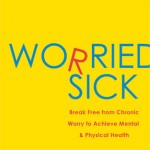By Carolyn Edlund
Today is the tomorrow we worried about yesterday. ~Author Unknown
Are you a worry-wart? With our economy in the tank, it’s very challenging to sell art. Life becomes unsettled, and worrying has become more common than ever. Fear not, says nationally known speaker and psychotherapist Karol Ward, who is the author of the book Worried Sick: Break Free from Chronic Worry to Achieve Mental & Physical Health. There are ways to cope. I caught up with Karol recently and we spoke about how artists can get a better understanding of why they worry and how they can deal with it.
AS: Please explain the types of worry, and the most common sources.
KW: There are two different kinds of worry that are the most common. The first is chronic worry, which is a constant, on-going feeling that does not go away even if there are not specific reasons for the feeling of worry. It is a feeling inside that gets projected or placed upon the outside world. I describe chronic worry as the feeling that the person experiencing it is wearing a pair of “worry glasses” that they view their circumstances through. Everything seen through those lenses is a cause for concern and the wearer is on-guard in anticipation of a “worst case scenario”.
This type of worry usually stems from core beliefs learned in childhood, trauma or series of traumas that result in the perception that the world is not necessarily a safe or comfortable place to live in. Chronic worry can be viewed as a coping mechanism used to handle the fear of the unknown.
Situational worry is the second kind of worry that people experience. This worry happens from the outside in. Upsetting events and situations occur that stimulate a natural “worry response”. However, this response is not static and is not the person’s usual mindset. This type of worry encompasses personal and professional circumstances and can be short or long term. Health issues, the economy, financial, career satisfaction, and relationship glitches are all examples of situational worries.
With this type of worry, there is the understanding that the worry comes from a specific cause and when that issue or problem is resolved, the worry will shift. A person experiencing situational worry is also able to take in another person’s perspective on their issue and feel a shift in mood. Though some situational worries can be long term, there is still the understanding that the circumstance is the cause of the worry as opposed to the blanket feeling of anxiety associated with chronic worry.
AS: Artists often have sporadic or uneven income from their work, creating feelings of insecurity. How can they change their mindset to deal  with this?
with this?
KW: In my practice, I have treated many artists who feel shame and embarrassment over the fact that they are not successful yet or do not have the consistent annual income that others do. I support them by having them explore and ultimately dismantle their belief in an economic standard that will never work for them. Then we work on defining what success looks like specifically to them and to recognize the signs and steps that would help them realize they are moving forward. These steps are unique to that artist and acknowledging them helps the artist nurture their specific path.
Also, in my experience, artists often overlook one of their greatest strengths that people in other fields do not or cannot handle. That strength is the ability to balance the passion of their work with the resiliency needed to weather economic insecurity. Now, I know many artists would rather not experience the insecurity that comes from having to worry about income but it is often a consistent aspect of an artist’s career. It seems funny but during tough economic times, I have known many artists who can handle the worry and stress better than those in more traditional fields. That is something artists can be proud of, which helps them with their core perception of who they are.
AS: Quite often the artist doesn’t “fit” into society’s definition of success, and has a lot of self-doubt. What coping mechanisms can be used to overcome this?
KW: As I mentioned earlier, I am a big believer in defining what success looks and feels like to that specific artist. This will be different not only in contrast to other fields but also among artists. So, first it’s important to let go of trying to fit into society’s definition of success. Then I have them try a version of the specific exercise below.
- Find a comfortable spot to sit and relax
- Close your eyes and breathe in through your nose and exhale slowly through your mouth 3 or 4 times
- Ask yourself if you were to achieve success tomorrow, what would it look like? (Be specific with this in terms of recognition, money or lifestyle)
- How would you notice that your life was different?
- How would you feel?
- What is one step you could take that would help you notice you were moving toward that vision of success?
- How would it feel to take that step?
- When will you do it?
One other suggestion I make is for the artist to surround themselves with people who inspire and support them. It is important to be around others who, even if they are not specifically artists, are open to the possibilities of life. While there is certainly room for the times when we all feel negative and insecure, it does not serve us to constantly be immersed in the impossibility of life rather than the possibility.
AS: What would you suggest for artists who feel conflicted about pursuing the business and self-promotion side of their work?
KW: Explore those ingrained beliefs about business and self-promotion. Who did you learn them from? How does not embracing the knowledge needed to be a success in your career benefit you? Sometimes hiding our gift’s from the world are something we learned earlier on and in reality are not who we are today. Sometimes it reflects a fear of losing control of the familiar world we live in now.
It’s important to explore what losing control would look like and is it really as scary as where our imagination takes us. Artists should also educate themselves by reading about how others they admire got there – even those in other fields. There are also some great books about the emotional relationship people have with money. You don’t have to be an expert in accounting or business to be a success, but you do need to be open to learning about how you view it. The more comfortable you are with what you want, the better choices you will make in regards to who you feel comfortable with in helping you achieve the success you want to create.
AS:What are some of the effects of chronic worry? How can we dig ourselves out of this cycle?
KW: Chronic worry affects people physically, psychologically and behavioral.
- Physical effects include: Muscle tension, headaches, stomach problems, jaw pain and digestive issues.
- Psychological effects include: Nervousness, irritability, tearfulness, low grade anxiety, negative attitude.
- Behavioral effects include: Over or under eating, over drinking, working, shopping, or spending. Sleep disturbances and or withdrawal in personal relationships.
I recommend tapping into what I call the Three C’s to help with worry.
Calmness: Finding ways to achieve physical calmness through some form of movement or through specific breathing exercises.
Clarity: Exploring beliefs or creating specific plans that makes the artist feel more in charge of their life.
Community: Connecting to resources or people for emotional, mental, and spiritual support.
Remember the goal is not to eliminate worry from our lives because that is impossible. Worry is a normal response to things we need to pay attention to that are causing us concern. What we are aiming for is managing, understanding and reducing worry so that it does not take over our lives.



Speak Your Mind